change time Citroen C CROSSER DAG 2010.5 1.G Owner's Manual
[x] Cancel search | Manufacturer: CITROEN, Model Year: 2010.5, Model line: C CROSSER DAG, Model: Citroen C CROSSER DAG 2010.5 1.GPages: 217, PDF Size: 6.56 MB
Page 25 of 217
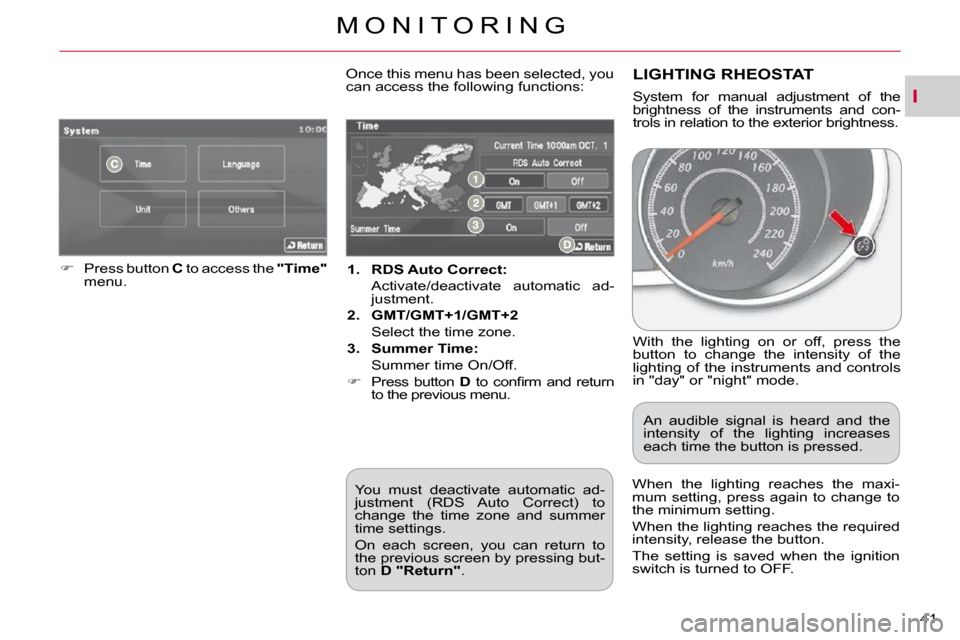
I
M O N I T O R I N G
41
1. RDS Auto
Correct
:
Activate/deactivate automatic ad- justment.
2. GMT/GMT+1/GMT+2
Select the time zone.
3. Summer Time:
Summer time On/Off.
� Press button D� � �t�o� �c�o�n�fi� �r�m� �a�n�d� �r�e�t�u�r�n�
to the previous menu.
� Press button C to access the "Time"
menu .
You must deactivate automatic ad-
justment (RDS Auto Correct) to
change the time zone and summer
time settings.
� �O�n� �e�a�c�h� �s�c�r�e�e�n�,� �y�o�u� �c�a�n� �r�e�t�u�r�n� �t�o�
the previous screen by pressing but-
ton D "Return" .
� �O�n�c�e� �t�h�i�s� �m�e�n�u� �h�a�s� �b�e�e�n� �s�e�l�e�c�t�e�d�,� �y�o�u�
can access the following functions: LIGHTING RHEOSTAT
� �W�i�t�h� �t�h�e� �l�i�g�h�t�i�n�g� �o�n� �o�r� �o�f�f�,� �p�r�e�s�s� �t�h�e�
button to change the intensity of the
lighting of the instruments and controls
in "day" or "night" mode.
When the lighting reaches the maxi-
�m�u�m� �s�e�t�t�i�n�g�,� �p�r�e�s�s� �a�g�a�i�n� �t�o� �c�h�a�n�g�e� �t�o�
the minimum setting.
� �W�h�e�n� �t�h�e� �l�i�g�h�t�i�n�g� �r�e�a�c�h�e�s� �t�h�e� �r�e�q�u�i�r�e�d�
�i�n�t�e�n�s�i�t�y�,� �r�e�l�e�a�s�e� �t�h�e� �b�u�t�t�o�n�.�
The setting is saved when the ignition
switch is turned to OFF. An audible signal is heard and the
intensity of the lighting increases
each time the button is pressed.
System for manual adjustment of the
brightness of the instruments and con-
trols in relation to the exterior brightness.
Page 27 of 217
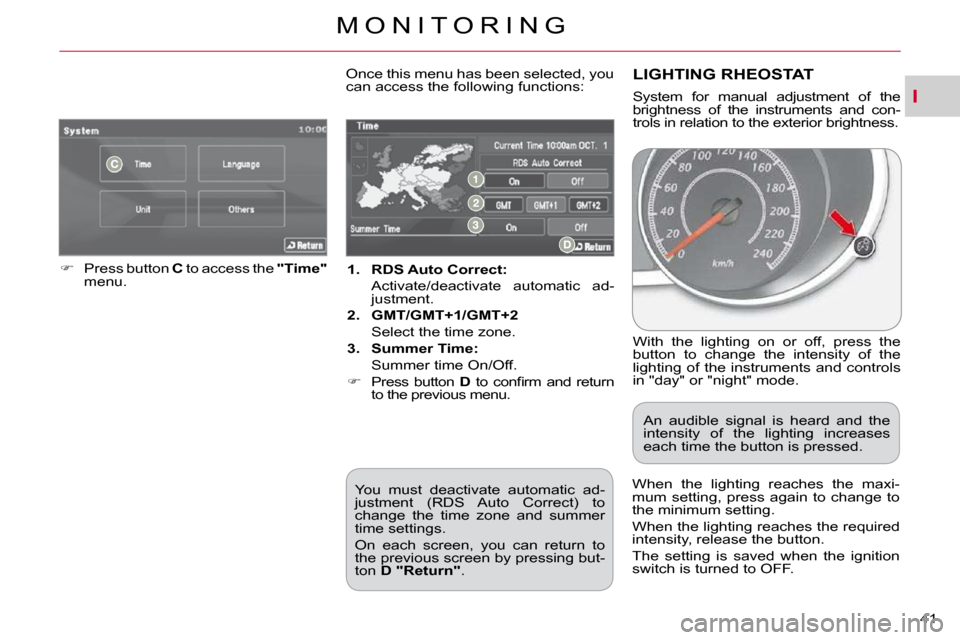
I
M O N I T O R I N G
41
1. RDS Auto
Correct
:
Activate/deactivate automatic ad- justment.
2. GMT/GMT+1/GMT+2
Select the time zone.
3. Summer Time:
Summer time On/Off.
� Press button D� � �t�o� �c�o�n�fi� �r�m� �a�n�d� �r�e�t�u�r�n�
to the previous menu.
� Press button C to access the "Time"
menu .
You must deactivate automatic ad-
justment (RDS Auto Correct) to
change the time zone and summer
time settings.
� �O�n� �e�a�c�h� �s�c�r�e�e�n�,� �y�o�u� �c�a�n� �r�e�t�u�r�n� �t�o�
the previous screen by pressing but-
ton D "Return" .
� �O�n�c�e� �t�h�i�s� �m�e�n�u� �h�a�s� �b�e�e�n� �s�e�l�e�c�t�e�d�,� �y�o�u�
can access the following functions: LIGHTING RHEOSTAT
� �W�i�t�h� �t�h�e� �l�i�g�h�t�i�n�g� �o�n� �o�r� �o�f�f�,� �p�r�e�s�s� �t�h�e�
button to change the intensity of the
lighting of the instruments and controls
in "day" or "night" mode.
When the lighting reaches the maxi-
�m�u�m� �s�e�t�t�i�n�g�,� �p�r�e�s�s� �a�g�a�i�n� �t�o� �c�h�a�n�g�e� �t�o�
the minimum setting.
� �W�h�e�n� �t�h�e� �l�i�g�h�t�i�n�g� �r�e�a�c�h�e�s� �t�h�e� �r�e�q�u�i�r�e�d�
�i�n�t�e�n�s�i�t�y�,� �r�e�l�e�a�s�e� �t�h�e� �b�u�t�t�o�n�.�
The setting is saved when the ignition
switch is turned to OFF. An audible signal is heard and the
intensity of the lighting increases
each time the button is pressed.
System for manual adjustment of the
brightness of the instruments and con-
trols in relation to the exterior brightness.
Page 28 of 217
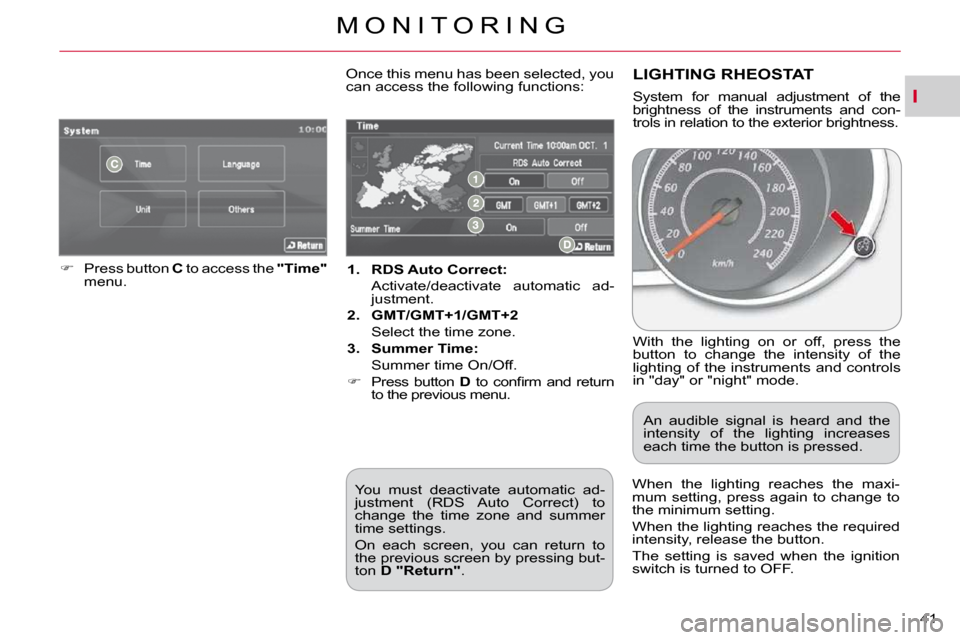
I
M O N I T O R I N G
41
1. RDS Auto
Correct
:
Activate/deactivate automatic ad- justment.
2. GMT/GMT+1/GMT+2
Select the time zone.
3. Summer Time:
Summer time On/Off.
� Press button D� � �t�o� �c�o�n�fi� �r�m� �a�n�d� �r�e�t�u�r�n�
to the previous menu.
� Press button C to access the "Time"
menu .
You must deactivate automatic ad-
justment (RDS Auto Correct) to
change the time zone and summer
time settings.
� �O�n� �e�a�c�h� �s�c�r�e�e�n�,� �y�o�u� �c�a�n� �r�e�t�u�r�n� �t�o�
the previous screen by pressing but-
ton D "Return" .
� �O�n�c�e� �t�h�i�s� �m�e�n�u� �h�a�s� �b�e�e�n� �s�e�l�e�c�t�e�d�,� �y�o�u�
can access the following functions: LIGHTING RHEOSTAT
� �W�i�t�h� �t�h�e� �l�i�g�h�t�i�n�g� �o�n� �o�r� �o�f�f�,� �p�r�e�s�s� �t�h�e�
button to change the intensity of the
lighting of the instruments and controls
in "day" or "night" mode.
When the lighting reaches the maxi-
�m�u�m� �s�e�t�t�i�n�g�,� �p�r�e�s�s� �a�g�a�i�n� �t�o� �c�h�a�n�g�e� �t�o�
the minimum setting.
� �W�h�e�n� �t�h�e� �l�i�g�h�t�i�n�g� �r�e�a�c�h�e�s� �t�h�e� �r�e�q�u�i�r�e�d�
�i�n�t�e�n�s�i�t�y�,� �r�e�l�e�a�s�e� �t�h�e� �b�u�t�t�o�n�.�
The setting is saved when the ignition
switch is turned to OFF. An audible signal is heard and the
intensity of the lighting increases
each time the button is pressed.
System for manual adjustment of the
brightness of the instruments and con-
trols in relation to the exterior brightness.
Page 29 of 217
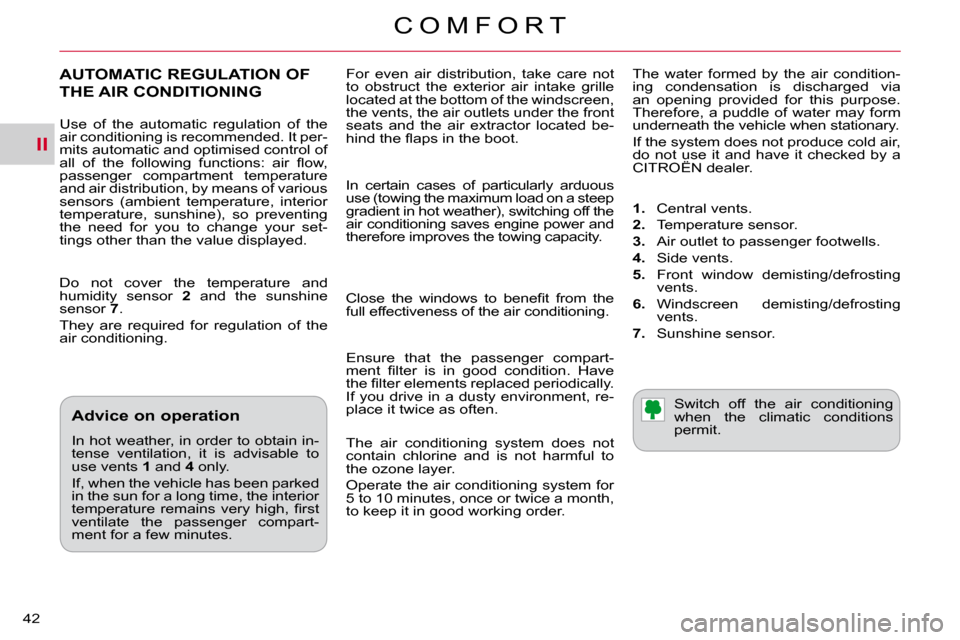
II
C O M F O R T
42
For even air distribution, take care not
to obstruct the exterior air intake grille
located at the bottom of the windscreen,
the vents, the air outlets under the front
seats and the air extractor located be-
�h�i�n�d� �t�h�e� �fl� �a�p�s� �i�n� �t�h�e� �b�o�o�t�.� The water formed by the air condition-
ing condensation is discharged via
�a�n� �o�p�e�n�i�n�g� �p�r�o�v�i�d�e�d� �f�o�r� �t�h�i�s� �p�u�r�p�o�s�e�.�
�T�h�e�r�e�f�o�r�e�,� �a� �p�u�d�d�l�e� �o�f� �w�a�t�e�r� �m�a�y� �f�o�r�m�
�u�n�d�e�r�n�e�a�t�h� �t�h�e� �v�e�h�i�c�l�e� �w�h�e�n� �s�t�a�t�i�o�n�a�r�y�.�
� �I�f� �t�h�e� �s�y�s�t�e�m� �d�o�e�s� �n�o�t� �p�r�o�d�u�c�e� �c�o�l�d� �a�i�r�,�
do not use it and have it checked by a
�C�I�T�R�O��N� �d�e�a�l�e�r�.� AUTOMATIC REGULATION OF
THE AIR CONDITIONING
� �D�o� �n�o�t� �c�o�v�e�r� �t�h�e� �t�e�m�p�e�r�a�t�u�r�e� �a�n�d
humidity sensor
2 and the sunshine
sensor 7� �.�
They are required for regulation of the
�a�i�r� �c�o�n�d�i�t�i�o�n�i�n�g�.�
Advice on operation
In hot weather, in order to obtain in-
tense ventilation, it is advisable to
use vents 1 and 4� � �o�n�l�y�.�
� �I�f�,� �w�h�e�n� �t�h�e� �v�e�h�i�c�l�e� �h�a�s� �b�e�e�n� �p�a�r�k�e�d�
in the sun for a long time, the interior
�t�e�m�p�e�r�a�t�u�r�e� �r�e�m�a�i�n�s� �v�e�r�y� �h�i�g�h�,� �fi� �r�s�t�
�v�e�n�t�i�l�a�t�e� �t�h�e� �p�a�s�s�e�n�g�e�r� �c�o�m�p�a�r�t�-
�m�e�n�t� �f�o�r� �a� �f�e�w� �m�i�n�u�t�e�s�.� Switch off the air conditioning
when the climatic conditions
�p�e�r�m�i�t�.� �
Use of the automatic regulation of the
�a�i�r� �c�o�n�d�i�t�i�o�n�i�n�g� �i�s� �r�e�c�o�m�m�e�n�d�e�d�.� �I�t� �p�e�r�-
�m�i�t�s� �a�u�t�o�m�a�t�i�c� �a�n�d� �o�p�t�i�m�i�s�e�d� �c�o�n�t�r�o�l� �o�f�
�a�l�l� �o�f� �t�h�e� �f�o�l�l�o�w�i�n�g� �f�u�n�c�t�i�o�n�s�:� �a�i�r� �fl� �o�w�,�
�p�a�s�s�e�n�g�e�r� �c�o�m�p�a�r�t�m�e�n�t� �t�e�m�p�e�r�a�t�u�r�e�
and air distribution, by means of various
�s�e�n�s�o�r�s� �(�a�m�b�i�e�n�t� �t�e�m�p�e�r�a�t�u�r�e�,� �i�n�t�e�r�i�o�r�
�t�e�m�p�e�r�a�t�u�r�e�,� �s�u�n�s�h�i�n�e�)�,� �s�o� �p�r�e�v�e�n�t�i�n�g�
the need for you to change your set-
�t�i�n�g�s� �o�t�h�e�r� �t�h�a�n� �t�h�e� �v�a�l�u�e� �d�i�s�p�l�a�y�e�d�.�
� �I�n� �c�e�r�t�a�i�n� �c�a�s�e�s� �o�f� �p�a�r�t�i�c�u�l�a�r�l�y� �a�r�d�u�o�u�s�
�u�s�e� �(�t�o�w�i�n�g� �t�h�e� �m�a�x�i�m�u�m� �l�o�a�d� �o�n� �a� �s�t�e�e�p�
�g�r�a�d�i�e�n�t� �i�n� �h�o�t� �w�e�a�t�h�e�r�)�,� �s�w�i�t�c�h�i�n�g� �o�f�f� �t�h�e�
�a�i�r� �c�o�n�d�i�t�i�o�n�i�n�g� �s�a�v�e�s� �e�n�g�i�n�e� �p�o�w�e�r� �a�n�d�
�t�h�e�r�e�f�o�r�e� �i�m�p�r�o�v�e�s� �t�h�e� �t�o�w�i�n�g� �c�a�p�a�c�i�t�y�.�
� �C�l�o�s�e� �t�h�e� �w�i�n�d�o�w�s� �t�o� �b�e�n�e�fi� �t� �f�r�o�m� �t�h�e�
�f�u�l�l� �e�f�f�e�c�t�i�v�e�n�e�s�s� �o�f� �t�h�e� �a�i�r� �c�o�n�d�i�t�i�o�n�i�n�g�.�
� �E�n�s�u�r�e� �t�h�a�t� �t�h�e� �p�a�s�s�e�n�g�e�r� �c�o�m�p�a�r�t�-
�m�e�n�t� �fi� �l�t�e�r� �i�s� �i�n� �g�o�o�d� �c�o�n�d�i�t�i�o�n�.� �H�a�v�e�
�t�h�e� �fi� �l�t�e�r� �e�l�e�m�e�n�t�s� �r�e�p�l�a�c�e�d� �p�e�r�i�o�d�i�c�a�l�l�y�.�
If you drive in a dusty environment, re-
�p�l�a�c�e� �i�t� �t�w�i�c�e� �a�s� �o�f�t�e�n�.�
The air conditioning system does not
contain chlorine and is not harmful to
�t�h�e� �o�z�o�n�e� �l�a�y�e�r�.�
� �O�p�e�r�a�t�e� �t�h�e� �a�i�r� �c�o�n�d�i�t�i�o�n�i�n�g� �s�y�s�t�e�m� �f�o�r�
5 to 10 minutes, once or twice a month,
�t�o� �k�e�e�p� �i�t� �i�n� �g�o�o�d� �w�o�r�k�i�n�g� �o�r�d�e�r�.�
1. � � �C�e�n�t�r�a�l� �v�e�n�t�s�.�
2. � � �T�e�m�p�e�r�a�t�u�r�e� �s�e�n�s�o�r�.�
3. � � �A�i�r� �o�u�t�l�e�t� �t�o� �p�a�s�s�e�n�g�e�r� �f�o�o�t�w�e�l�l�s�.�
4. � � �S�i�d�e� �v�e�n�t�s�.�
5. Front window demisting/defrosting
�v�e�n�t�s�.�
6. Windscreen demisting/defrosting
�v�e�n�t�s�.�
7. � � �S�u�n�s�h�i�n�e� �s�e�n�s�o�r�.� �
Page 106 of 217

VII
111
Stopping - Starting on a slope
Do not use the accelerator pedal to
immobilise the vehicle on a slope,
apply the
parking brake
instead.
When starting on a slope, accelerate
gradually while releasing the parking
brake.
Switching to sequential mode
Once you have moved off, you can
switch to sequential mode by selecting
position +/- .
"D" disappears and the gears engaged
appear in succession on the instrument
panel screen.
The gear change requests are only car-
ried out if the engine speed permits it.
Take your foot off the accelerator pedal
gently to engage the gear.
Switching to automated mode
Automated mode
After using the sequential mode, you
can return to the automated mode by
selecting position D .
"D" appears on the instrument panel
screen.
The gearbox then operates in auto-active
mode, without any action on the part of
the driver.
It continuously selects the gear most
suited to the conditions of:
- driving style,
- road characteristics,
- vehicle load.
To optimise driving comfort and obtain
the most suitable gear, avoid sharp
variations in the pressure on the
accelerator pedal.
Auto sequential mode
In the automated mode, you can take
over control temporarily at any time us-
ing the steering mounted controls.
The use of these controls permits manual
selection of the gears in situations which
require a faster changedown than that
offered in automated mode (arrival at a
roundabout, exit from a car park with a
steep gradient, overtaking...). Stopping the vehicle
Before switching off the engine, you can:
- move to position N to leave the
gearbox in neutral.
� � �-� � �l�e�a�v�e� �a� �g�e�a�r� �e�n�g�a�g�e�d�,� �s�u�c�h� �a�s� �fi� �r�s�t� or reverse.
In both cases, you must apply the park-
ing brake to immobilise the vehicle.
Operating anomaly
With the ignition on, if the message
"Slow down" or "Maintenance re-
quired" appears on the multifunction
screen, this indicates a gearbox mal-
function.
When a message is displayed, carry
out the following operations:
- slow down and stop your vehicle in a safe place,
- place the lever in position N and let
the engine run,
- open the bonnet to allow the engine to cool.
If the message disappears for a long
period, you can set off again.
If the message remains displayed or
appears frequently, contact a CITROËN
dealer without delay.
�P�r�e�s�s� �t�h�e� �b�r�a�k�e� �p�e�d�a�l� �fi� �r�m�l�y�
while starting the engine.
Start the engine. "N" appears on the in-
strument panel display.
� �S�e�l�e�c�t� �fi� �r�s�t� �g�e�a�r� �(�p�o�s�i�t�i�o�n� � D or +/- ) or re-
verse (position R ).
Release the handbrake.
Release the brake pedal then accelerate.
"D" or "1" or "R" appear on the instru-
ment panel display. The gearbox engages the gear re-
quested if the engine speed permits it.
The gear engaged appears.
To return to the automated mode, press
the back of the
"+/OFF" control for ap-
proximately 2 seconds.
At low speeds, when approaching a
�s�t�o�p� �o�r� �t�r�a�f�fi� �c� �l�i�g�h�t�s� �f�o�r� �e�x�a�m�p�l�e�,� �t�h�e�
�g�e�a�r�b�o�x� �c�h�a�n�g�e�s� �d�o�w�n� �t�o� �fi� �r�s�t� �g�e�a�r�
automatically.
Page 109 of 217
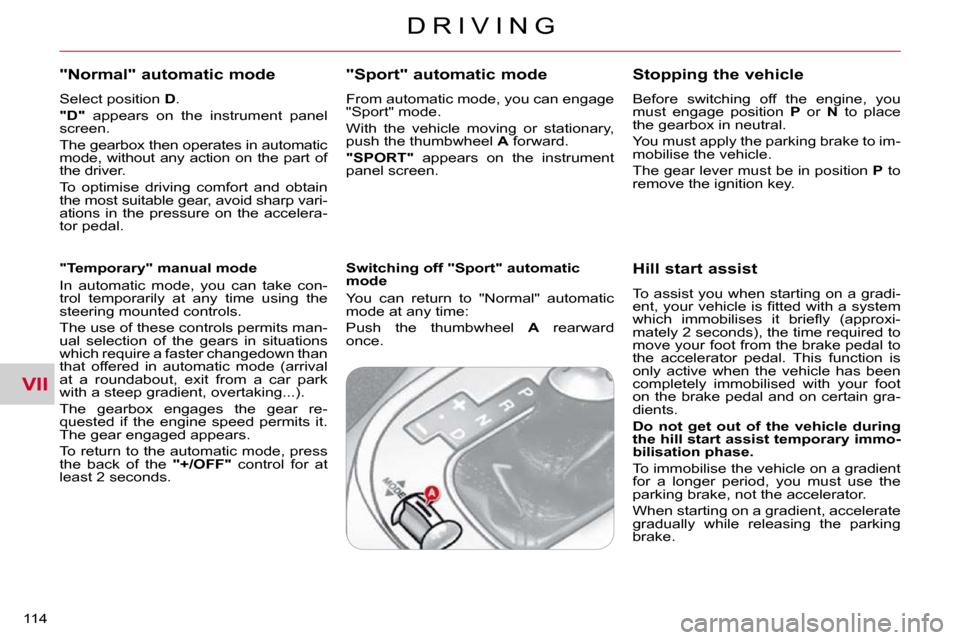
VII
D R I V I N G
114
"Normal" automatic mode
Select position D .
"D" appears on the instrument panel
screen.
The gearbox then operates in automatic
mode, without any action on the part of
the driver.
To optimise driving comfort and obtain
the most suitable gear, avoid sharp vari-
ations in the pressure on the accelera-
tor pedal.
"Temporary" manual mode
In automatic mode, you can take con-
trol temporarily at any time using the
steering mounted controls.
The use of these controls permits man-
ual selection of the gears in situations
which require a faster changedown than
that offered in automatic mode (arrival
at a roundabout, exit from a car park
with a steep gradient, overtaking...).
The gearbox engages the gear re-
quested if the engine speed permits it.
The gear engaged appears.
To return to the automatic mode, press
the back of the "+/OFF" control for at
least 2 seconds.
"Sport" automatic mode
From automatic mode, you can engage
"Sport" mode.
With the vehicle moving or stationary,
push the thumbwheel A forward.
"SPORT" appears on the instrument
panel screen.
Switching off "Sport" automatic
mode
You can return to "Normal" automatic
mode at any time:
Push the thumbwheel A rearward
once. Before switching off the engine, you
must engage position
P or N to place
the gearbox in neutral.
You must apply the parking brake to im-
mobilise the vehicle.
The gear lever must be in position P
to
remove the ignition key.
Stopping the vehicle
Hill start assist
To assist you when starting on a gradi-
�e�n�t�,� �y�o�u�r� �v�e�h�i�c�l�e� �i�s� �fi� �t�t�e�d� �w�i�t�h� �a� �s�y�s�t�e�m�
�w�h�i�c�h� �i�m�m�o�b�i�l�i�s�e�s� �i�t� �b�r�i�e�fl� �y� �(�a�p�p�r�o�x�i�-
mately 2 seconds), the time required to
move your foot from the brake pedal to
the accelerator pedal. This function is
only active when the vehicle has been
completely immobilised with your foot
on the brake pedal and on certain gra-
dients.
Do not get out of the vehicle during
the hill start
assist
temporary immo-
bilisation phase.
To immobilise the vehicle on a gradient
for a longer period, you must use the
parking brake, not the accelerator.
When starting on a gradient, accelerate
gradually while releasing the parking
brake.
Page 158 of 217
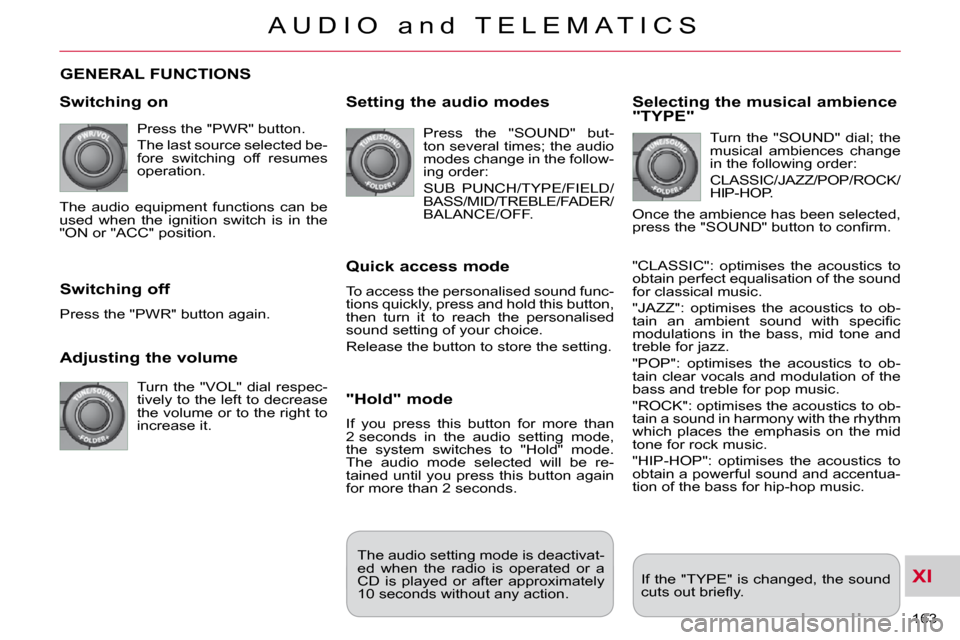
XI
163
A U D I O a n d T E L E M A T I C S
GENERAL FUNCTIONS
Switching on
Press the "PWR" button.
The last source selected be-
fore switching off resumes
operation.
Adjusting the volume
Turn the "VOL" dial respec-
tively to the left to decrease
the volume or to the right to
increase it.
Switching off
Press the "PWR" button again.
Setting the audio modes
Press the "SOUND" but-
ton several times; the audio
modes change in the follow-
ing order:
SUB PUNCH/TYPE/FIELD/
BASS/MID/TREBLE/FADER/
BALANCE/OFF.
Quick access mode
To access the personalised sound func-
tions quickly, press and hold this button,
then turn it to reach the personalised
sound setting of your choice.
Release the button to store the setting.
"Hold" mode
If you press this button for more than
2 seconds in the audio setting mode,
the system switches to "Hold" mode.
The audio mode selected will be re-
tained until you press this button again
for more than 2 seconds.
Selecting the musical ambience "TYPE"
Turn the "SOUND" dial; the
musical ambiences change
in the following order:
CLASSIC/JAZZ/POP/ROCK/
HIP-HOP.
Once the ambience has been selected,
�p�r�e�s�s� �t�h�e� �"�S�O�U�N�D�"� �b�u�t�t�o�n� �t�o� �c�o�n�fi� �r�m�.�
"CLASSIC": optimises the acoustics to
obtain perfect equalisation of the sound
for classical music.
"JAZZ": optimises the acoustics to ob-
�t�a�i�n� �a�n� �a�m�b�i�e�n�t� �s�o�u�n�d� �w�i�t�h� �s�p�e�c�i�fi� �c�
modulations in the bass, mid tone and
treble for jazz.
"POP": optimises the acoustics to ob-
tain clear vocals and modulation of the
bass and treble for pop music.
"ROCK": optimises the acoustics to ob-
tain a sound in harmony with the rhythm
which places the emphasis on the mid
tone for rock music.
"HIP-HOP": optimises the acoustics to
obtain a powerful sound and accentua-
tion of the bass for hip-hop music.
If the "TYPE" is changed, the sound
�c�u�t�s� �o�u�t� �b�r�i�e�fl� �y�.� �
The audio setting mode is deactivat-
ed when the radio is operated or a
CD is played or after approximately
10 seconds without any action.
The audio equipment functions can be
used when the ignition switch is in the
"ON or "ACC" position.
Page 159 of 217
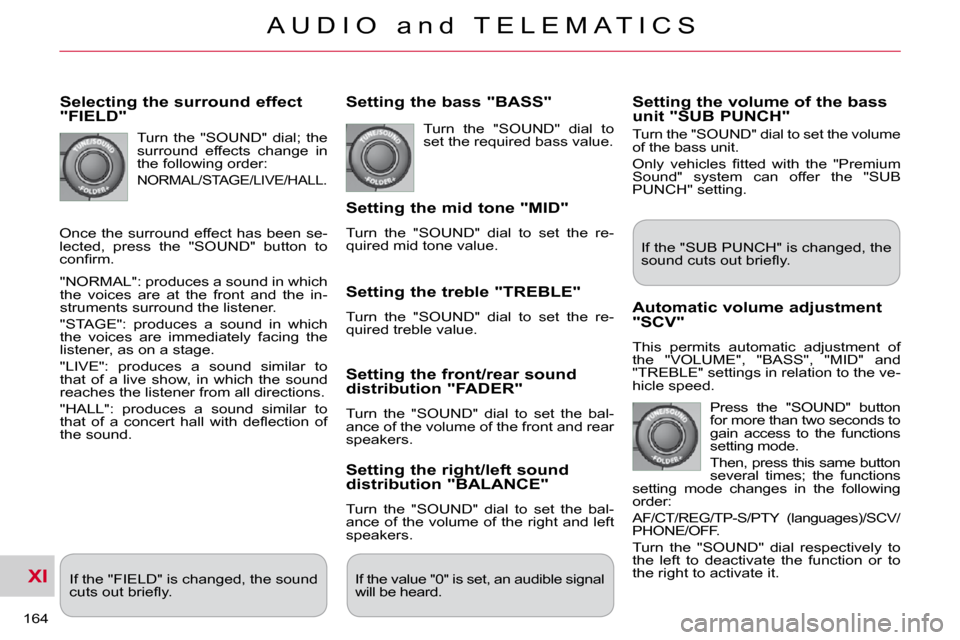
XI
164
A U D I O a n d T E L E M A T I C S
Selecting the surround effect "FIELD"
Turn the "SOUND" dial; the
surround effects change in
the following order:
NORMAL/STAGE/LIVE/HALL.
"NORMAL": produces a sound in which
the voices are at the front and the in-
struments surround the listener.
"STAGE": produces a sound in which
the voices are immediately facing the
listener, as on a stage.
"LIVE": produces a sound similar to
that of a live show, in which the sound
reaches the listener from all directions.
"HALL": produces a sound similar to
�t�h�a�t� �o�f� �a� �c�o�n�c�e�r�t� �h�a�l�l� �w�i�t�h� �d�e�fl� �e�c�t�i�o�n� �o�f�
the sound.
Setting the bass "BASS"
Turn the "SOUND" dial to
set the required bass value.
Setting the mid tone "MID"
Turn the "SOUND" dial to set the re-
quired mid tone value.
Setting the treble "TREBLE"
Turn the "SOUND" dial to set the re-
quired treble value.
Setting the front/rear sound distribution "FADER"
Turn the "SOUND" dial to set the bal-
ance of the volume of the front and rear
speakers.
Setting the right/left sound distribution "BALANCE"
Turn the "SOUND" dial to set the bal-
ance of the volume of the right and left
speakers.
If the "FIELD" is changed, the sound
�c�u�t�s� �o�u�t� �b�r�i�e�fl� �y�.� � If the value "0" is set, an audible signal
will be heard.
Automatic volume adjustment "SCV"
This permits automatic adjustment of
the "VOLUME", "BASS", "MID" and
"TREBLE" settings in relation to the ve-
hicle speed.
Press the "SOUND" button
for more than two seconds to
gain access to the functions
setting mode.
Then, press this same button
several times; the functions
setting mode changes in the following
order:
AF/CT/REG/TP-S/PTY (languages)/SCV/
PHONE/OFF.
Turn the "SOUND" dial respectively to
the left to deactivate the function or to
the right to activate it. If the "SUB PUNCH" is changed, the
�s�o�u�n�d� �c�u�t�s� �o�u�t� �b�r�i�e�fl� �y�.� �
Setting the volume of the bass unit "SUB PUNCH"
Turn the "SOUND" dial to set the volume
of the bass unit.
� �O�n�l�y� �v�e�h�i�c�l�e�s� �fi� �t�t�e�d� �w�i�t�h� �t�h�e� �"�P�r�e�m�i�u�m�
Sound" system can offer the "SUB
PUNCH" setting.
Once the surround effect has been se-
lected, press the "SOUND" button to
�c�o�n�fi� �r�m�.�
Page 160 of 217
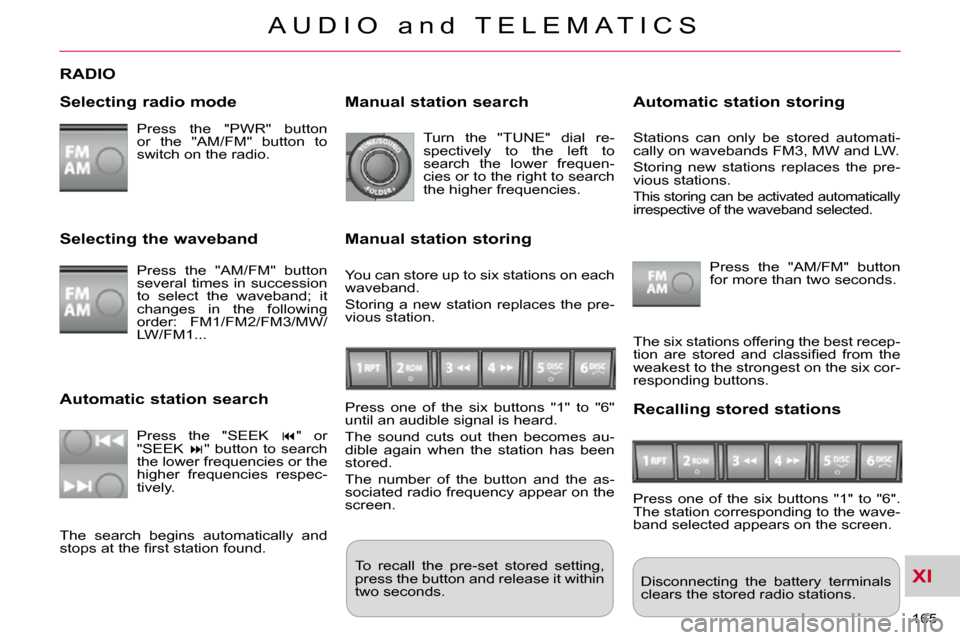
XI
165
A U D I O a n d T E L E M A T I C S
RADIO
Selecting radio mode
Press the "PWR" button
or the "AM/FM" button to
switch on the radio. Disconnecting the battery terminals
clears the stored radio stations.
Selecting the waveband
Press the "AM/FM" button
several times in succession
to select the waveband; it
changes in the following
order: FM1/FM2/FM3/MW/
LW/FM1...
Automatic station search
Press the "SEEK � " or
"SEEK � " button to search
the lower frequencies or the
higher frequencies respec-
tively.
Manual station search
Turn the "TUNE" dial re-
spectively to the left to
search the lower frequen-
cies or to the right to search
the higher frequencies.
Manual station storing
Press one of the six buttons "1" to "6"
until an audible signal is heard.
The sound cuts out then becomes au-
dible again when the station has been
stored.
The number of the button and the as-
sociated radio frequency appear on the
screen.
Automatic station storing
Press the "AM/FM" button
for more than two seconds.
Recalling stored stations
Press one of the six buttons "1" to "6".
The station corresponding to the wave-
band selected appears on the screen.
The search begins automatically and
�s�t�o�p�s� �a�t� �t�h�e� �fi� �r�s�t� �s�t�a�t�i�o�n� �f�o�u�n�d�.� � The six stations offering the best recep-
�t�i�o�n� �a�r�e� �s�t�o�r�e�d� �a�n�d� �c�l�a�s�s�i�fi� �e�d� �f�r�o�m� �t�h�e�
weakest to the strongest on the six cor-
responding buttons.
You can store up to six stations on each
waveband.
Storing a new station replaces the pre-
vious station. Stations can only be stored automati-
cally on wavebands FM3, MW and LW.
Storing new stations replaces the pre-
vious stations.
This storing can be activated automatically
irrespective of the waveband selected.
To recall the pre-set stored setting,
press the button and release it within
two seconds.
Page 161 of 217
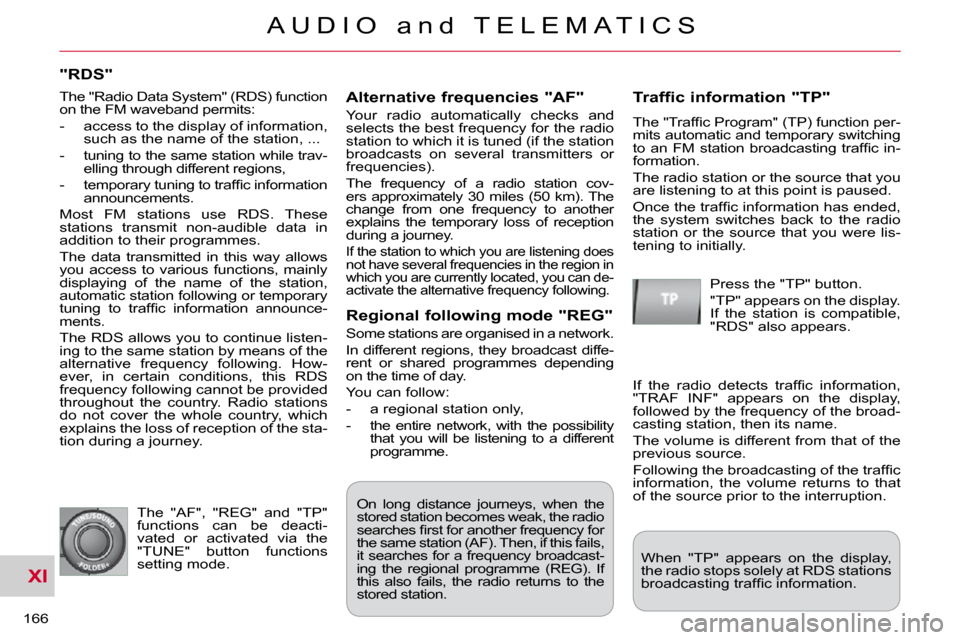
XI
166
A U D I O a n d T E L E M A T I C S
"RDS"
Alternative frequencies "AF"
Your radio automatically checks and
selects the best frequency for the radio
station to which it is tuned (if the station
broadcasts on several transmitters or
frequencies).
The frequency of a radio station cov-
ers approximately 30 miles (50 km). The
change from one frequency to another
explains the temporary loss of reception
during a journey.
If the station to which you are listening does
not have several frequencies in the region in
which you are currently located, you can de-
activate the alternative frequency following.
Traffic information "TP"
� �T�h�e� �"�T�r�a�f�fi� �c� �P�r�o�g�r�a�m�"� �(�T�P�)� �f�u�n�c�t�i�o�n� �p�e�r�-
mits automatic and temporary switching
�t�o� �a�n� �F�M� �s�t�a�t�i�o�n� �b�r�o�a�d�c�a�s�t�i�n�g� �t�r�a�f�fi� �c� �i�n�-
formation.
The radio station or the source that you
are listening to at this point is paused.
� �O�n�c�e� �t�h�e� �t�r�a�f�fi� �c� �i�n�f�o�r�m�a�t�i�o�n� �h�a�s� �e�n�d�e�d�,�
the system switches back to the radio
station or the source that you were lis-
tening to initially.
Regional following mode "REG"
Some stations are organised in a network.
In different regions, they broadcast diffe-
rent or shared programmes depending
on the time of day.
You can follow:
- a regional station only,
- the entire network, with the possibility that you will be listening to a different
programme.
The "AF", "REG" and "TP"
functions can be deacti-
vated or activated via the
"TUNE" button functions
setting mode. Press the "TP" button.
"TP" appears on the display.
If the station is compatible,
"RDS" also appears.
� �I�f� �t�h�e� �r�a�d�i�o� �d�e�t�e�c�t�s� �t�r�a�f�fi� �c� �i�n�f�o�r�m�a�t�i�o�n�,�
"TRAF INF" appears on the display,
followed by the frequency of the broad-
casting station, then its name.
The volume is different from that of the
previous source.
� �F�o�l�l�o�w�i�n�g� �t�h�e� �b�r�o�a�d�c�a�s�t�i�n�g� �o�f� �t�h�e� �t�r�a�f�fi� �c�
information, the volume returns to that
of the source prior to the interruption.
When "TP" appears on the display,
the radio stops solely at RDS stations
�b�r�o�a�d�c�a�s�t�i�n�g� �t�r�a�f�fi� �c� �i�n�f�o�r�m�a�t�i�o�n�.� �
On long distance journeys, when the
stored station becomes weak, the radio
�s�e�a�r�c�h�e�s� �fi� �r�s�t� �f�o�r� �a�n�o�t�h�e�r� �f�r�e�q�u�e�n�c�y� �f�o�r�
the same station (AF). Then, if this fails,
it searches for a frequency broadcast-
ing the regional programme (REG). If
this also fails, the radio returns to the
stored station.
The "Radio Data System" (RDS) function
on the FM waveband permits:
- access to the display of information,
such as the name of the station, ...
- tuning to the same station while trav- elling through different regions,
� � �-� � �t�e�m�p�o�r�a�r�y� �t�u�n�i�n�g� �t�o� �t�r�a�f�fi� �c� �i�n�f�o�r�m�a�t�i�o�n� announcements.
Most FM stations use RDS. These
stations transmit non-audible data in
addition to their programmes.
The data transmitted in this way allows
you access to various functions, mainly
displaying of the name of the station,
automatic station following or temporary
�t�u�n�i�n�g� �t�o� �t�r�a�f�fi� �c� �i�n�f�o�r�m�a�t�i�o�n� �a�n�n�o�u�n�c�e�-
ments.
The RDS allows you to continue listen-
ing to the same station by means of the
alternative frequency following. How-
ever, in certain conditions, this RDS
frequency following cannot be provided
throughout the country. Radio stations
do not cover the whole country, which
explains the loss of reception of the sta-
tion during a journey.